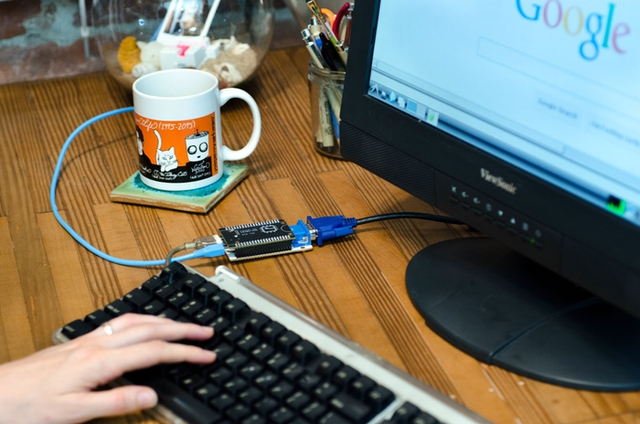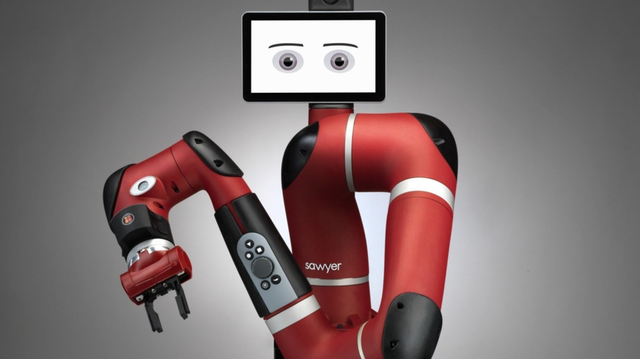Technology is developing at such a speed that we simply do not have time to get used to it. And sometimes it is even more difficult for a 'geek' to come to terms with it than for an ordinary user. About a $ 9 computer, a new one Android, robots, and ten-core mobile processors.

If there is no starting point, then everything loses its meaning.
Sergey Lukyanenko. Labyrinth of reflections
I remember very well the days when I spent a lot of time choosing components for a gaming computer, trying to get the maximum for the available amount. Nobody had heard of any eight-core processors then, but this did not prevent us from successfully playing beautiful games and working on computers of those years. A configuration based on a processor with a frequency of 1 GHz, 512 MB of RAM and 4 GB of hard drive was considered quite decent, and it was worth a fair amount. And even now, when such hardware is becoming difficult to find even in smartphones, these characteristics still sound quite weighty to my ear. If only because I remember how many interesting opportunities are behind these faceless numbers.
[iframe url = '// www.kickstarter.com/projects/1598272670/chip-the-worlds-first-9-computer/widget/video.html' width = '640 ″ height =' 360 ″ scrolling = 'no' frameborder = '0 ″ marginheight =' 0 ']
Guess how much, according to Next Thing engineers, such a computer should cost now? The correct answer is $ 9, and it will take up a little more space than a matchbox.



Link to news
Meanwhile, a new ten-core generation of mobile processors is on the way. This includes MediaTek Helio X20 (codenamed MT6797) which consists of two Cortex-A72 cores (2.5 GHz), four Cortex-A53 cores (2 GHz) and four energy efficient Cortex-A53 cores ( 1.4 GHz). Graphics accelerator – Mali-T880 MP4 with a frequency of 700 MHz. It was this processor that set a new record in the AnTuTu benchmark at the end of April, gaining more than 70,000 points.


Link to news
Of course, Qualcomm won't sit idly by either. Judging by the inside information of the STJS Gadgets resource, the Snapdragon 818 deca-core processor will receive the following characteristics:

It is rumored that this particular processor can be used in Xiaomi 5.
Link to news
Considering this or that device or phenomenon, we start from some point of reference, which we often chose many years ago. Technique has changed a lot during this time, but our assessment criteria have remained the same.
A classic example is the screen in the Galaxy S6. For an ordinary person who is not used to comparing displays of different types with each other, everything is clear here – a good screen with good viewing angles, a large supply of brightness and a pleasant picture. But for the 'geek' everything is much more complicated. After all, he, unlike ordinary buyers, knows a bunch of smart words and all sorts of important terms. And, of course, he will not forget about such a terrible thing as PenTile. Unlike gullible users, he cannot be deceived, he knows that the quality of the screen can only be determined under a microscope!



Macro screenshots are a thing widely known in a narrow circle, some connoisseurs love to compare them with each other and talk for a long time about the pros and cons of different types of screens. In fact, there is no point in looking at pixels under a magnifying glass for a long time, but habit is a strong thing. And I have no doubt that someone, even on 4K displays, will suffer from a grainy picture and complain about the cunning of marketers who incorrectly calculate ppi. Just out of habit.


Link to news
Another point is the attitude towards Chinese technology in general and smartphones in particular. Most ordinary buyers do not even think about where the smartphone was made, having long been accustomed to the fact that most of the equipment is to one degree or another 'Made in China'. If we are talking not just about assembling, but about developing a device, then the “Chinese” are still not trusted too much, but they may well buy – solely for the sake of economy, because “China” is always cheap and cheerful. Even if it is not at all prestigious and not particularly high quality.
Geek knows very well that it is among Chinese smartphones that you can find many amazing devices that are in no way inferior to the products of A-brands. The brand Xiaomi sounds as proud to him as Samsung, and ZTE's bezel-less smartphones are every bit as innovative as the Galaxy Edge's curved display. He noticed long ago that the products of Chinese companies are gradually becoming more expensive, that they are slowly beginning to position their devices as a full-fledged alternative to smartphones of more famous brands, and not just as a cheap substitute. And the fact that the cost of labor of Chinese workers, albeit slowly, but still growing, is also no secret for the geek. And this will sooner or later affect the production price.

The problem is that the same Foxconn is actively investing money in the development of robots for industrial automation. And if everything goes as planned, then the 'Chinese miracle' will surprise everyone more than once. For a simple buyer who cannot imagine China without super-cheap labor, nothing will change. But the geeks, who have been talking about the inevitable increase in prices for Chinese devices for several years now, will have to hastily change the disc.

Separately, I would like to note that we are not talking about plans for the distant future, but about quite specific work that is already yielding some result. For example, Foxconn recently announced that it has increased the number of robots on assembly lines iPad and iPhone by 50,000. This has not only increased production speed, but also reduced scrap.
The company has been producing such robots since 2007 and currently produces 10,000 models per year. It may well be that a company that has built its business on cheap labor will soon become one of the largest manufacturers of robotics and will significantly reduce its human staff.
Link to news
Of course, very few companies can afford to invest heavily in the development of robotics. But practically everyone can buy such a solution from intermediaries.

For example, this is how the Sawyer robot from Rethink Robotics looks like. First of all, the robot is intended for maintenance of machine tools, testing printed circuit boards and other work with electronics requiring high accuracy. The robot is completely safe and can work next to living people. Moreover, under the guidance of the operator, he can even learn useful new 'tricks'.
[iframe url = '// www.youtube.com/embed/S4mULTknb2I' width = '640 ″ height =' 360 ″ scrolling = 'no' frameborder = '0 ″ marginheight =' 0 ']
The robot's vision system is based on a wide-angle camera in the 'head' and an additional camera in the 'wrist'. The robot's 'arm' is capable of lifting a load weighing up to four kilograms and contains a series of special sensors that help to work with jewelry on the most complex and fragile objects.
Link to news
It should be noted here that not only electronics are subject to assembly, and many other things can be automated in this way. For example, building construction, which is also developing at an impressive pace in China.
Not so long ago, the Chinese company Broad Sustainable Construction officially announced that it was going to build a huge 220-storey skyscraper in just 90 days, collecting 5 floors a day.

At first glance, it sounds like a bad joke. And on the second – like frank fantasy, to which we will grow, at best, in a hundred years. In fact, this company has already proven that its high-speed construction technology (or rather, 'assembly') is not just empty words. A few years ago, Broad Sustainable Construction erected a 30-story hotel in just 15 days.
The construction process, which consisted of assembling a building from different sections, is demonstrated in the video below.
[iframe url = '// www.youtube.com/embed/rwvmru5JmXk' width = '640 ″ height =' 360 ″ scrolling = 'no' frameborder = '0 ″ marginheight =' 0 ']
Link to news
Another example of fast-aging habits is Google's new Nexus smartphone. Or, more precisely, smartphones, because according to rumors, this time there may be as many as two of them. Presumably, LG is engaged in the development of one device, and Huawei.
Many users are used to the fact that Nexus devices not only have the latest OS at the time of release, but also have a very attractive price. But will this ride of unprecedented generosity continue? The past Nexus from Motorola casts doubt on this.

At the same time, the geeks do not want to look at the flagships of other companies, not so much because of the high price, but because of the fear of not receiving a new version in a year Android. Needless to say, once there were huge problems with this – some companies managed to 'forget' to update even their most expensive devices, and this despite the fact that updates were often released and changed quite a lot. But now the situation with updating flagship devices (and the price of new smartphones may turn out to be quite 'flagship') has changed, and at least the next major update Android can be safely counted on. And given that Google only guarantees Nexus updates for a year and a half, the difference is not that noticeable.
Link to news
By the way, a new version Android codenamed Android M is also clearly not far off. True, not too much is known about her yet. It is assumed that the main focus will be on the corporate segment and those people who use a smartphone for work. It is expected to have an advanced voice control and a voice notification system, a special service for determining the user's location in space called Nearby (this will involve not only the GPS module, but also a microphone, Bluetooth, a gyroscope, a light sensor, etc.), and further development of Material Design ideas.


Link to news
Speaking of habits, one cannot fail to mention the choice of a mobile OS. While many commentators, out of habit, continue to prove to each other the impossibility of abandoning the usual OS, more and more people are no longer paying any attention to it. People choose a specific product, not an operating system, which has become as boring in specifications as the processor model or the weight of the device.

For example, according to Kantar WorldPanel analysts, about a third of all buyers of the new iPhone used phones on Android before. I don't have similar statistics about Galaxy S or other Android flagships, but I have no doubt that the numbers there will be exactly the same. And this is great – even if in this area there will be less prejudice and blind fanaticism.
Link to news

